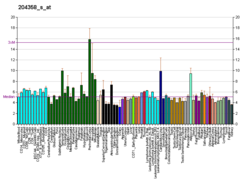| FLRT2 |
|---|
|
| Available structures |
|---|
| PDB | Ortholog search: PDBe RCSB |
|---|
| List of PDB id codes |
|---|
4V2C, 4V2D |
|
|
| Identifiers |
|---|
| Aliases | FLRT2, fibronectin leucine rich transmembrane protein 2 |
|---|
| External IDs | OMIM: 604807; MGI: 3603594; HomoloGene: 8291; GeneCards: FLRT2; OMA:FLRT2 - orthologs |
|---|
| Gene location (Human) |
|---|
 | | Chr. | Chromosome 14 (human)[1] |
|---|
| | Band | 14q31.3 | Start | 85,530,144 bp[1] |
|---|
| End | 85,654,428 bp[1] |
|---|
|
| Gene location (Mouse) |
|---|
 | | Chr. | Chromosome 12 (mouse)[2] |
|---|
| | Band | 12|12 E | Start | 95,659,000 bp[2] |
|---|
| End | 95,751,989 bp[2] |
|---|
|
| RNA expression pattern |
|---|
| Bgee | | Human | Mouse (ortholog) |
|---|
| Top expressed in | - germinal epithelium
- parietal pleura
- middle temporal gyrus
- retinal pigment epithelium
- spinal ganglia
- Brodmann area 23
- trigeminal ganglion
- body of pancreas
- tibia
- Epithelium of choroid plexus
|
| | Top expressed in | - Rostral migratory stream
- ciliary body
- retinal pigment epithelium
- vestibular membrane of cochlear duct
- epithelium of lens
- endothelial cell of lymphatic vessel
- sciatic nerve
- vas deferens
- hand
- conjunctival fornix
|
| | More reference expression data |
|
|---|
| BioGPS | 
 | | More reference expression data |
|
|---|
|
| Gene ontology |
|---|
| Molecular function | - protein-macromolecule adaptor activity
- fibroblast growth factor receptor binding
- protein kinase inhibitor activity
- chemorepellent activity
| | Cellular component | - cytoplasm
- organelle membrane
- integral component of membrane
- endoplasmic reticulum membrane
- membrane
- intracellular membrane-bounded organelle
- cell-cell junction
- focal adhesion
- synapse
- integral component of plasma membrane
- extracellular region
- cell junction
- endoplasmic reticulum
- neuron projection
- extracellular exosome
- plasma membrane
- extracellular space
- extracellular matrix
| | Biological process | - negative chemotaxis
- negative regulation of protein kinase activity
- cytokine-mediated signaling pathway
- cell adhesion involved in heart morphogenesis
- heart morphogenesis
- axon guidance
- multicellular organism development
- cell adhesion
- basement membrane organization
- regulation of neuron migration
- negative regulation of receptor signaling pathway via JAK-STAT
- positive regulation of synapse assembly
- fibroblast growth factor receptor signaling pathway
- biological process
| | Sources:Amigo / QuickGO |
|
| Orthologs |
|---|
| Species | Human | Mouse |
|---|
| Entrez | | |
|---|
| Ensembl | | |
|---|
| UniProt | | |
|---|
| RefSeq (mRNA) | |
|---|
NM_001346143
NM_001346144
NM_001346145
NM_001346146
NM_013231 |
| |
|---|
| RefSeq (protein) | |
|---|
NP_001333072
NP_001333073
NP_001333074
NP_001333075
NP_037363 |
| |
|---|
| Location (UCSC) | Chr 14: 85.53 – 85.65 Mb | Chr 12: 95.66 – 95.75 Mb |
|---|
| PubMed search | [3] | [4] |
|---|
|
| Wikidata |
| View/Edit Human | View/Edit Mouse |
|



















